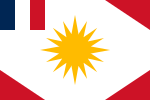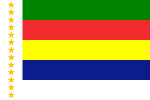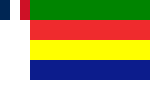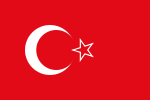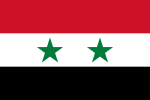Flag Of Syria
As a result of the Syrian Civil War since 2011, there are at least two flags used to represent Syria, used by different factions in the war.
The incumbent government of the Syrian Arab Republic led by the Ba'ath Party uses the red-white-black tricolour originally used by the United Arab Republic, while Syrian opposition factions such as the Syrian National Coalition use the green-white-black tricolour known as the ''Independence flag'', first used by Mandatory Syria.
Flag of Syria
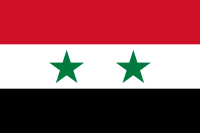 | |
| Flag of United Arab Republic (1958–1961) Flag of Syrian Arab Republic (1980–present) | |
| Use | National flag and ensign |
|---|---|
| Proportion | 2:3 |
| Adopted | 22 February 1958, abandoned on 28 September 1961;readopted on 30 March 1980 |
| Design | A horizontal tricolour of red, white, and black; charged with two green stars at the centre. |

The current flag was first adopted in 1958 to represent Syria as part of the United Arab Republic, and was used until 1961. It was readopted in 1980. Since its first adoption, variations of the red-white-black flag have been used in various Arab Unions of Syria with Egypt, Libya, Sudan, Yemen, and Iraq. Although Syria is not part of any Arab state union, the flag of the United Arab Republic was readopted to show Syria's commitment to Arab unity. The usage of the flag has become disputed because it is often associated with the Ba'ath Party and has come to represent parties loyal to Bashar al-Assad's government in the Syrian civil war.
The Syrian flag is described in Article 6 of the Syrian Constitution. The first paragraph of the Article states:
The flag of the Syrian Arab Republic consists of four colours: red, white and black, with two green stars, of five angles each. The flag is rectangular, with its width measuring two-thirds of its length. It is divided into three rectangles of identical dimensions and have the same length as the flag. The upper one is red, the middle being white and the bottom one is black, with the two green stars in the middle of the white rectangle.
— 1st Paragraph of Article 6 of the Syrian Constitution
The flag is based on the Arab Liberation Flag, which had four colours – black, green, white and red – representing four major dynasties of Arab history: Abbasids, Faṭimids, Umayyads, and Hashimites.
Interpretation of the colors
| Color | Symbolism |
|---|---|
| Red | The Hashemite dynasty, bloody struggle for freedom. |
| White | The Umayyad dynasty, bright and peaceful future. |
| Green | The Fatimid dynasty or the Rashidun caliphs, the stars representing Egypt and Syria. |
| Black | The Abbasid dynasty, strong rule. |
Color approximations
| Red | White | Green | Black | |
|---|---|---|---|---|
| RGB | 206/17/38 | 255/255/255 | 0/122/61 | 0/0/0 |
| Hexadecimal | #ce1126 | #FFFFFF | #007a3d | #000000 |
| CMYK | 12/100/98/3 | 0/0/0/0 | 89/27/100/15 | 75/68/67/90 |
| Pantone | 186 C | White | 7726 C | Black |
| Red | White | Black | Gold | |
|---|---|---|---|---|
| RGB | 206/17/38 | 255/255/255 | 0/0/0 | 239/187/34 |
| Hexadecimal | #ce1126 | #FFFFFF | #000000 | #efbb22 |
| CMYK | 12/100/98/3 | 0/0/0/0 | 75/68/67/90 | 7/26/99/0 |
| Pantone | 186 C | White | Black | 7409 C |
Flag of the Syrian opposition
 | |
| Syrian opposition flag Syrian revolution flag | |
| Use | Opposition and revolution flag |
|---|---|
| Proportion | 2:3 (disputed) |
| Adopted | Originally in 1932 with 1:2 aspect ratio, was readopted in 1961. Adopted with 2:3 aspect ratio in 2011 by opposition government-in-exile (sometimes the original 1:2 aspect ratio flag is used unofficially). |
| Design | A horizontal triband of green, white, and black, with three red stars charged in the center. |
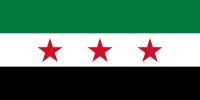 | |

During the ongoing civil war, the Syrian opposition, represented by the Syrian National Council, then by the National Coalition for Syrian Revolutionary and Opposition Forces (commonly named the Syrian National Coalition) used a modified version of the independence flag first used in 1932 with a 2:3 aspect ratio. The modified independence flag began to be used as a universal display of the protesting opposition in late 2011. The opposition wanted to distinguish themselves from the current Syrian government and favoured the use of the flag used when Syria gained its independence from France. Khaled Kamal, an official from the Syrian National Council, now believes this flag to also represent independence and the end of Bashar al-Assad's government. Today the flag is mainly used in areas controlled by the Syrian National Coalition. The use of the modified independence flag is similar to the Libyan rebels' use of the pre-Gaddafi red-black-green-white Libyan flag from the era of the Kingdom of Libya in opposition to Muammar Gaddafi's green flag. The original 1:2 aspect ratio flag has been used by the opposition unofficially on several occasions.
Historic flags of Syria
Kingdom of Syria (1920)

The Ottoman flag had been used in Syria until Ottomans left the country on 18 September 1918. In 1918, the official flag of Syria was the Faysal flag, or Flag of the Arab Revolt, the flag of the 1916–1918 Arab Revolt against the Ottomans. It was officially adopted by the Hashemite family on 30 September 1918 and remained in use until 8 March 1920. This was the first flag to use the green/red/white/black combination seen in most subsequent Syrian flags. The colours' symbolism has been described as follows: white for the Damascene Umayyad period, green for the Caliph Ali, red for the Khawarij radical Islamic movement, and black for the Islamic prophet Muhammad, showing the "political use of religion" in opposition to the increasingly secularized Turkish colonial rule. Alternately, it has been argued that the horizontal colors stand for the Abbasid (black), Umayyad (white) and Fatimid (green) Caliphates and the red triangle to the Hashemite dynasty.
Under the Arab Kingdom of Syria, the Faysal flag was redesigned with a 7-pointed white star imposed on the red triangle, and was in use until 24 July 1920. This flag was, however, adopted by Jordan somewhat later. The kingdom lasted for just over 4 months in 1920 before being occupied by France and formally incorporated into the French colonial empire for some 12 years.
French Mandate flags (1920–32)

The Faysal flag was abandoned with the arrival of French colonials to Syria. The French High Commissioner for Syria, General Henri Gouraud adopted the new flag of the French Mandate of Syria (blue with a white crescent, see below) on 24 July 1920. The flag was based on the flag of the Shebab Emirate used between 1697 and 1842, which stood for "the love of peace". Gouraud's flag was in use until 1 September 1920, after which Syria was split into separate territories, each eventually given its own flag (see below). On 22 June 1922 Gouraud established the Federation of Syria, which used a green-white-green flag with a French flag canton. When this federation was consolidated into the State of Syria in 1925 the same flag continued to be used until the establishment of the republic on 14 May 1930.
Independence flag
French Mandate and independence (1930–58, 1961–63)

The flag of the newly established Syrian Republic, under the French mandate was determined by the 1930 constitution. The constitution was drafted by a parliamentary committee led by nationalist leader Ibrahim Hananu. At first, French authorities refused to allow the constituent assembly to ratify the constitution, and Henri Ponsot, the High Commissioner of the Levant, dissolved the assembly on 5 February 1929. After a public uproar, French authorities rescinded their decision and decided to approve the draft with some changes. On 14 May 1930, Ponsot issued decree number 3111, which approved the Syrian-drafted "Constitution of the Syrian Republic", and which in Article IV of Part I states:
"[The] Syrian flag will be as follows: length double width, and is divided into three parallel and equal colours, the highest green, white then black, that the white section contains in a straight line three red five-pointed stars".
— Article IV, Part I, Constitution of the Syrian Republic
The flag's green colour stood for the Rashidun, white represented the Umayyads and black symbolised the Abbasids. Originally, the three red stars represented the three districts of Syria: the "states" of Aleppo, Damascus, and Deir ez-Zor. In 1936, the Sanjak of Latakia and Jebel Druze were added to Syria, and the representation of the three stars was changed, with the first representing the districts of Aleppo, Damascus and Deir ez-Zor, the second Jebel Druze, and the final star representing Sanjak of Latakia. The flag was used as a symbol for the desire for autonomy, for Syrians to rally around when France reneged on its agreement to leave the country, due to the outbreak of World War II. The symbolism was as follows: black for the dark oppressed past, white for a promising future and red for the blood to be sacrificed to move from the former to the latter. The flag was adopted when Syria gained its independence on 17 April 1946. The standard was used until the creation of the United Arab Republic, a state union of Syria and Egypt, in 1958. After the collapse of the United Arab Republic, Syria continued to use the UAR's flag until 28 September 1961, when the independence flag was restored to disassociate Syria from the former failed union.
Ba'athist flags
The current two-star flag of Syria was first adopted by Gamal Abdel Nasser, the then president of Egypt and later the president of the United Arab Republic. The flag was changed from the former independence flag in April 1958 along with associated laws designed to create a greater Arab identity. The new flag took the coloured red-white-black bands from the Egyptian revolutionary flag, and the stars on the flag were changed from red to green to indicate the pan-Arab colours. The two stars represented Egypt and Syria.
After Syria left the UAR on 28 September 1961, the previous independence flag was readopted to disassociate Syria from the failed union.
Following the 1963 Ba'athist coup d'état, a new flag was adopted by its Revolutionary Command Council on 8 March 1963, and was used until 1 January 1972. In 1963, the Ba'athist regime came to power in Iraq as well, and the two Ba'athist governments began negotiations in Cairo in order to once again form a union between Egypt, Syria and Iraq. The process failed after the Iraqi Ba'athist government was overthrown in November 1963 but both Syria and Iraq did adopt a new flag to represent the union. This flag was not much different from the flag of the UAR, with only a change from two stars to three, in order to represent the addition of Iraq to the Federation. The three stars represented the unity of Egypt, Syria and Iraq, as well as three pillars of Ba'athism: unity, freedom, and socialism.
President Hafez al-Assad adopted a new flag on 1 January 1972, as Syria joined Egypt and Libya in the Federation of Arab Republics. The green stars were replaced by the Hawk of Quraish (the symbol of the tribe of Muhammad). The eagle held the ribbon with the name of the Federation, but unlike Egypt and Libya, Syria did not include its name on the coat of arms. This flag was an official flag during the Yom Kippur War in 1973. The Federation was dissolved in 1977, but Syria continued to use the flag for the next three years. The flag was abrogated on 29 March 1980, and replaced by the current two-star flag in order to show Syria's commitment to Arab unity.
List of flags of Syria
The following section below is a list of flags used in Syria.
National flags
- Flag of the Arab Kingdom of Syria (1920)
- Henri Gouraud's flag of the Mandate of Syria (1920)
- Flag of the State of Aleppo (1920–1925)
- Flag of the State of Damascus (1920–1925)
- Flag of the Alawite State (1920–1936)
- Flag of the Jabal Druze State (1921–1924)
- Flag of the Jabal Druze State (1924–1936)
- Civil flag of the Jabal Druze State (1921–1936)
- Flag of the independent Hatay State (1938–1939)
- Flag of the Syrian Federation (1922–1925) and the State of Syria (1925–1930)
- Flag of the First Syrian Republic (1930–1950) and the Second Syrian Republic (1950–1958)
- Flag of the United Arab Republic (1958–1961)
- Flag of the Syrian Arab Republic (1961–1963)
- Flag of the Syrian Arab Republic (1963–1972)
- Flag of Syria in the Federation of Arab Republics and after (1972–1980)
- Flag of the Syrian Arab Republic (1980–present)
- Flag used by the Syrian National Coalition and Interim Government (2011–present)
- Flag of the Syrian Salvation Government (2018–present)
Presidental flags
| Flag | Date | Use | Description |
|---|---|---|---|
 | 1980–present | Presidential flag of Syria | A horizontal tricolour of red, white and black with 2 dark green stars. |
 | 1972–1980 | Presidential flag of Syria | A horizontal tricolour of red, white and black with the old emblem of Egypt. |
 | 1963–1972 | Presidential flag of Syria | A horizontal tricolour of red, white and black with 3 dark green stars. |
 | 1958–1961 | Presidential flag of Syria | A horizontal tricolour of red, white and black with 2 dark green stars. The coloured emblem of Egypt is at the top-left hoist. |
 | 1941–1958, 1961–1963 | Presidential flag of Syria | A horizontal tricolour of dark green, white and black with 3 red stars. |
Royal flags
Military flags
| Flag | Date | Use | Description |
|---|---|---|---|
 | 1946–present | Flag of Syrian Armed Forces | Flag of Syria with the Coat of Arms of the Syrian Armed Forces in the top left hand corner. Across the top the flag says "Homeland Honor Devotion" (وطن شرف إخلاص), and "Syrian Arab Army" (الجيش العربي السوري) across the bottom. |
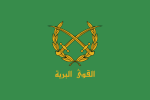 | 1945–present | Flag of Syrian Army | Green background with the coat of arms of the army in the middle of center. |
 | 1950–present | Flag of Syrian Navy | Blue background with the coat of arms of the navy in the middle of center. |
 | post-2007–present | Flag of Syrian Air Force | Turquoise background with their badge in the middle of the center. |
Ensigns flags
| Flag | Date | Use | Description |
|---|---|---|---|
 | post-2007 | Flag of Syrian Air Force Ensign | Almost grey background with the Syrian flag to the top left hoist and the roundel of the air force at the middle of the center. |
Ethnic Groups flags
| Flag | Date | Use | Description |
|---|---|---|---|
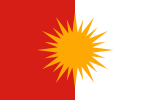 | ?-Today | Flag of the Yazidis | Red and white vertical blocks with a yellow 24-pointed star. |
 | ?-Today | Flag of the Syrian Turkmens | Teal background with 2 stripes, one at the top and one at the bottom, with the unofficial emblem of Turkey. |
Organizations flags
| Flag | Date | Use | Description |
|---|---|---|---|
 | 2013-Today | Flag of the Sultan Murad Brigade | A red background with golden Arabic text with a golden line separating two lines. |
 | 2014-2018 | Flag of Harakat Sham al-Islam | Black background with a bent line with the crescent joint, under them is the jihadist text with another Arabic text at the bottom. |
 | early 2012-2015 | Flag of Liwaa al-Umma | Black background with the jihadist text with a sword at the bottom of it with another arabic text on the bottom of it. |
 | 2014-2015 | Flag of the Hazzm Movement | White background with the jihadist text with two swords merged together and one green Arabic text at the bottom. |
 | 2013-2014 | Administration flag of the Islamic Front | White background with the ISIS text on top, then the logo on black at the bottom. |
 | 2013-2014 | War flag of the Islamic Front | Black background with the ISIS text on top, then the logo at the bottom. |
 | 2012-2015 | Flag of the Knights of Justice Brigade | White background with red Arabic text on the top and bottom with a horse's head mixed with the old Syrian flag. |
 | 2014-Today | Flag of the Sham Legion | White background with the logo in the middle of center. |
 | 2013-Today | Flag of Sootoro | White background with the logo in the middle of center. |
 | 2011-Today | Flag of Syrian Resistance | Red background with their insignia in the middle of center. |
Political parties flags
| Flag | Date | Use | Description |
|---|---|---|---|
 | 1986-Today | Flag of Bakdash Communist Party | Red background with the communist symbol. |
 | 2013-Today | Flag of Arab Nationalist Guard | Black background with the emblem colors switched. |
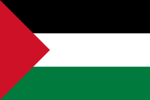 | 1947-Today | Flag of Ba'ath Party | Black, white and green horizontal rectangles with a red flipped triangle to the left hoist. |
 | 2017-Today | Flag of Democratic Union Party | White background with their emblem. |
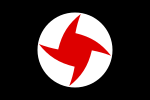 | 1932-Today | Flag of Syrian Social Nationalist Party | Black background with their logo. |
 | 2015-Today | Flag of Turkistan Islamic Party | Black background with the shahada text and Arabic text at the bottom. |
 | 2000-2005 | Flag of Bethnahrin Freedom Party | Blue background with a 32-pointed yellow star and wheats crossed below it, below the wheats are Arabic text and the text "GHB". On the top left hoist is a red shooting star. |
See also
References
This article uses material from the Wikipedia English article Flag of Syria, which is released under the Creative Commons Attribution-ShareAlike 3.0 license ("CC BY-SA 3.0"); additional terms may apply (view authors). Content is available under CC BY-SA 4.0 unless otherwise noted. Images, videos and audio are available under their respective licenses.
®Wikipedia is a registered trademark of the Wiki Foundation, Inc. Wiki English (DUHOCTRUNGQUOC.VN) is an independent company and has no affiliation with Wiki Foundation.














